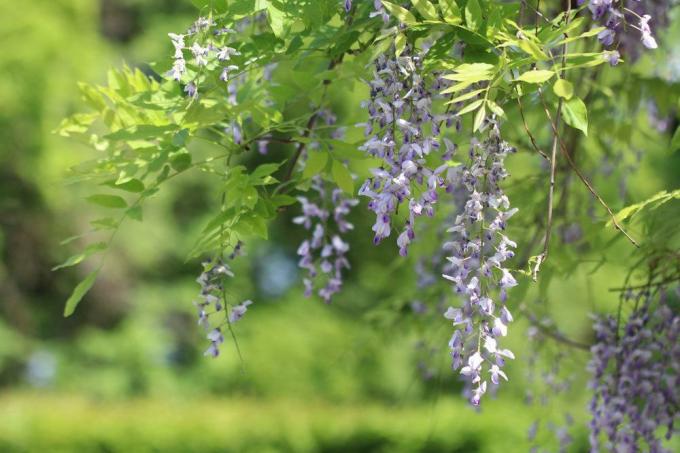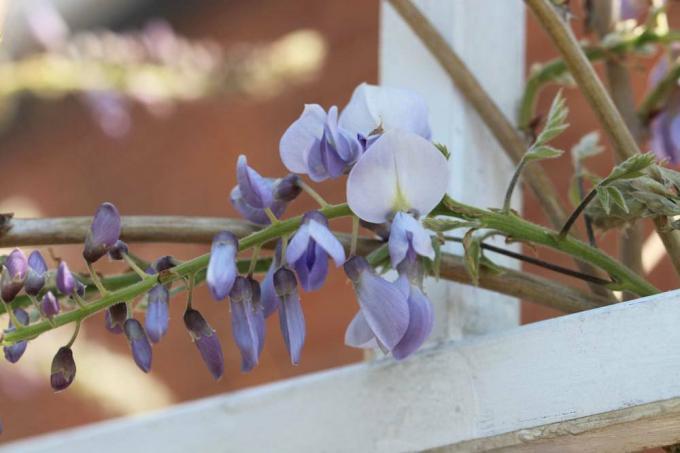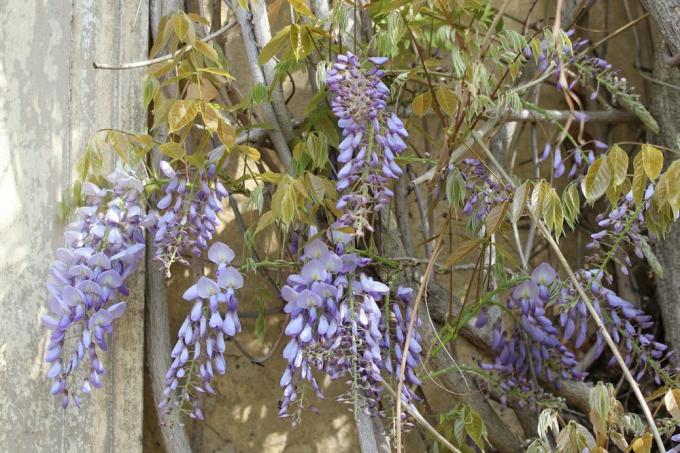
table of contents
- Wisteria
- Location
- floor
- Underground
- Young plant
- Cut
- to water
- Repot
- Fertilize
- Revive
Thanks to its long flower clusters, the Wisteria a real feast for the eyes. It causes the hobby gardener all the more grief when he does not want to bloom or no longer wants to bloom. This article explains why this can be and how best to counteract it with eleven practical tips.
Wisteria
The wisteria is a lush climbing plant. Its grape-like flowers fill the garden with life and amaze the viewer. Again and again, however, one hears and reads that one's own wisteria simply does not want to bloom. There are many possible causes. This guide explains the most important reasons. In addition, the practical tips help to solve the respective problem.
Location
Choose the right location
If the location is not right, it is very possible that the wisteria does not like to bloom. He needs a warm and sunny place to be able to develop optimally. It also thrives in partial shade, but with a much smaller flower. It is essential to avoid full shade.
Tip: Ideally, this plant is planted on a south wall.
It is also important not to place the climbing plant too close to a rain gutter. It could climb up there and cause considerable damage.
Tip: Even if the proximity to a rain gutter is taboo - the wisteria definitely needs a climbing aid, as it grows very strongly. It is best to rely on stable rod-like supports. Wire ropes are also very suitable. Only wooden scaffolding should be avoided, because the wisteria will destroy them.
From all of this it also follows that this plant needs a lot of space in the garden. This has to be taken into account when planting.

floor
Pay attention to lime-poor soil
A very chalky soil can cause the wisteria to refuse to show its intense flowers. If there is too much lime, its leaves turn yellow and often fall off.
So you can test the lime content yourself, you need:
- 8 to 10 percent hydrochloric acid (chemical: HCI)
- Watch glass or porcelain bowl
- Suction pipette
- teaspoon
- Soil sample
How to proceed:
- Place a teaspoon of a dry soil sample on the watch glass or porcelain bowl
Note: Take the soil sample directly at the location of the wisteria.
- Fill the pipette with hydrochloric acid
- Put a drop of the hydrochloric acid on the edge of the sample
- observe the degree of foaming
Key:
- a) no visible or audible roaring - no limescale
- b) only audible hissing close to the ear - calcium content <1%
- c) weak, short effervescence - 1 to 2% lime content
- d) distinct, short effervescence - cold portion 2 to 4%
- e) strong, long-lasting effervescence - lime content> 5%
The result is attached a) until c), everything is fine so far. Otherwise, from now on you should only pour rainwater to reduce the lime content.

Underground
Ensure the ideal subsurface
In addition to the calcium deficiency or -free space, the soil must have a few other properties in order to function as the perfect sub-surface for the wisteria. It should be made as follows.
- rich in humus
- acidic to neutral
- moist but permeable
If just one of these points is wrong, it can happen that the plant does not bloom as desired.
Young plant
Be patient or rethink
Maybe the lack of bloom is simply because the wisteria is too young for it. Depending on the variety, the plant blooms for the first time after two to three years or significantly later. Some species even let the hobby gardener wait a full ten years until they develop flowers.
Tip: Refined specimens bloom much earlier than unrefined plants. The latter are often only ready for the first time after many years.
Attention, wisteria propagated from seeds generally bloom very rarely. Therefore, one should rely on cuttings, ideally in combination with grafting. The best thing to do is to find out how things are going with your own wisteria with regard to the points described. And until it blooms, the rich foliage also inspires, which appears light green in spring and more yellowish in autumn.
Cut
Prune the plant properly for the first two years
The right cut plays an important role right from the start. If you make mistakes here, it is entirely possible that the flower will not bloom. Wisteria not only grows abundantly, it also grows very quickly. That's why you have to lend a hand in the first two years.
- shorten the lower side shoots down to two eyes
- Remove all shoots close to the ground and wild shoots
Cut wisteria correctly from the third year onwards
It continues with the right cutting. From the third year onwards there are a few more things to consider.
- Cut back the new shoots by half in late summer (end of August)
Important: The side shoots must not be longer than the main frame.
- the wisteria continues to grow until frost, so one finds in spring on those cut in summer Usually sprouted new growths - these again on three to five eyes at the end of February / beginning of March shorten
- Completely remove shoots that produce little or no green at all
- When cutting back, check the attachment of the climbing aid and adjust it if necessary

If you stick to all points, you can usually look forward to a rich flowering in the same year. Conversely, mistakes in pruning can reduce the willingness to flower.
Tip: If the climbing shoots are allowed to continue to grow unhindered, the wisteria decays into a vegetative growth behavior, which has a negative effect on the flowering.
Incidentally, you can use the clippings to increase the wisteria. But more on that in another guide.
to water
Provide wisteria with plenty of water
The wisteria is very demanding in terms of water supply. In summer you should give the tree plenty of water - preferably by placing the lower part of the bowl in the water. But, the wisteria doesn't keep soaking wet all year round.
Those who do not adequately satisfy the thirst of the plant need not be surprised if it does not or hardly blooms in the New Year. Incidentally, despite the summer "bath", the roots do not rot.
Repot
Do not repot the plant too often
Some hobby gardeners tend to repot their wisteria relatively often. However, this can significantly reduce the ability to flower.
Tip: The wisteria should not be repotted more often than every five years.
Note: The type of water supply and repotting described above go hand in hand. As a result of the rare repotting, the root ball gradually thickens. This is just as necessary and therefore desirable for a good flower approach. However, the compaction makes it difficult to water sufficiently only from above. The wisteria needs a lot of water, especially in summer - that's why the water bowl is recommended.
Fertilize
Fertilize properly for a good nutrient base
Fertilizing is a critical point for almost every plant, including wisteria. Even the smallest mistakes can inhibit flowering. Therefore you should pay close attention to when and how much you fertilize.
Tip: Fertilize heavily after flowering, approximately until July. Then give less.
This ensures that the wisteria plant the flower buds for the next year and that the growth of foliage over the summer is limited.

Do not remove nodule bacteria
Wisteria is one of the butterflies. In this group of plants, so-called nodule bacteria (rhizobia) are found on the roots. Inexperienced / ignorant hobby gardeners often consider the nodules to be root cancer and cut them away when repotting. However, this is wrong and should be avoided at all costs if you want to guarantee a beautiful bloom!
The bacteria have an important task: they take up elementary nitrogen in a symbiosis with the wisteria and make this available to the plant (to put it simply).
Revive
Animate old wisteria to bloom
If an old wisteria no longer blooms, you can try to (re) animate it again with a courageous cut back. In the coming years, the new shoots should be better protected. Flowering may then occur after two to three years.
Important: Of course, this only works if the plant has no other problems - i.e. other reasons for the lack of flowering can be ruled out.



